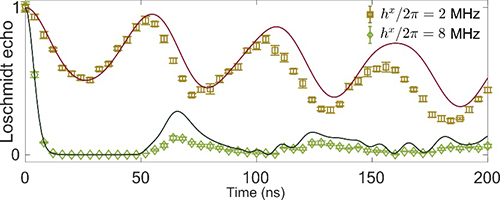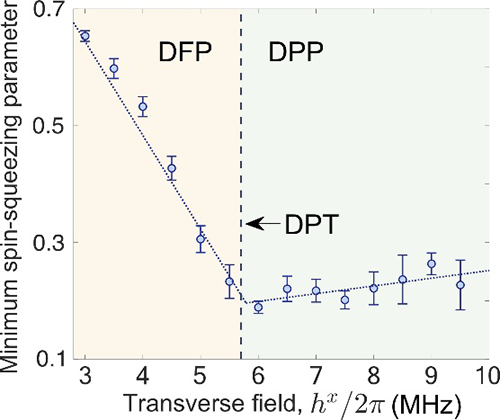Progress in superconducting quantum computation: quantum simulation of dynamical phase transitions
Date:18-06-2020 Print
Quantum simulation uses a controllable quantum system to mimic complex systems or solve intractable problems, among which the non-equilibrium problems of quantum many-body systems have attracted wide research interest since they are hard to simulate using classical computers. Instead, popular quantum simulators, such as superconducting circuits, can provide insights into these problems. As considerable advances have been made in scalability, coherence and controllability, superconducting circuits have become one of the most important quantum simulation platforms.
Recently, a research group from Institute of Physics, Chinese Academy of Sciences, Zhejiang University and RIKEN in Japan, have successfully performed quantum simulation of dynamical phase transitions in a Lipkin-Meshkov-Glick model with a 16-qubit superconducting quantum simulator.
Dynamical phase transition (DPT) is a kind of nonequilibrium phase transitions and have been theoretically investigated in various quantum many-body models. There are two types of DPT. The first type DPT (DPT-1) focuses on the non-equilibrium order parameter, while the second type DPT (DPT-2) is characterized by the non-analytical behaviors of Loschmidt echo associated with the Lee-Yang-Fisher zeros in statistical mechanics. Further theoretical and numerical investigations reveal that the DPT-1 and DPT-2 can be studied in the same framework.
The quantum processor integrates 20 superconducting qubits which are all coupled to a common resonator bus, which was used to generate Schrödinger cat states in previous work. This time, 16 qubits are used to engineer the Lipkin-Meshkov-Glick (LMG) model by applying controllable transverse field to each qubit. The system is driven into a non-equilibrium state with microwaves and then evolve under the LMG model. Firstly, typical features of the DPT-1 are observed (Fig. 1). For small transverse field, the system stays in the dynamical ferromagnetic phase (DFP), the magnetization exhibits a slow relaxation. However, given a strong transverse field, the system enters into the dynamical paramagnetic phase (DPP), the magnetization exhibits a large oscillation at an early time and approaches zero in the long-time limit. The time-averaged magnetization as the non-equilibrium order parameter is zero in the DPP, while it becomes finite in the DFP. Next, the researchers demonstrate that there exists the zeros of Loschmidt echo in the DPP, suggesting the relation between DPT-1 and DPT-2 (Fig. 2).
In addition, the researchers explore the DPTs from a novel perspective. They study the minimum spin squeezing as a probe of the phase transition. The experimental results show that the minimum value of the spin-squeezing parameters can be attained very close to the critical point of the DPT. This indicates a potential application of the DPT to quantum metrology.
This study entitled "Probing dynamical phase transitions with a superconducting quantum simulator" was published on Science Advances.
The study was supported by the National Basic Research Program of China, the National Natural Science Foundation of China, the Strategic Priority Research Program of Chinese Academy of Sciences, the China Postdoctoral Science Foundation and grants from Japan.

Fig. 1 Time evolution of the magnetization and time-averaged magnetization as a function of transverse field.

Fig. 2 Time evolution of the Loschmidt echo.

Fig. 3 The minimum spin-squeezing parameter as a function of transverse field.
Contact:
Institute of Physics
FAN Heng
Email: hfan@iphy.ac.cn
Key word:
Superconducting qubits; Dynamical phase transitions; Quantum simulation;
Abstract:
Nonequilibrium quantum many-body systems, which are difficult to study via classical computation, have attracted wide interest. Quantum simulation can provide insights into these problems. Here, using a programmable quantum simulator with 16 all-to-all connected superconducting qubits, we investigate the dynamical phase transition in the Lipkin-Meshkov-Glick model with a quenched transverse field. Clear signatures of dynamical phase transitions, merging different concepts of dynamical criticality, are observed by measuring the nonequilibrium order parameter, nonlocal correlations, and the Loschmidt echo. Moreover, near the dynamical critical point, we obtain a spin squeezing of -7.0 ± 0.8 dB, showing multipartite entanglement, useful for measurements with precision fivefold beyond the standard quantum limit. On the basis of the capability of entangling qubits simultaneously and the accurate single-shot readout of multiqubit states, this superconducting quantum simulator can be used to study other problems in nonequilibrium quantum many-body systems, such as thermalization, many-body localization, and emergent phenomena in periodically driven systems.

